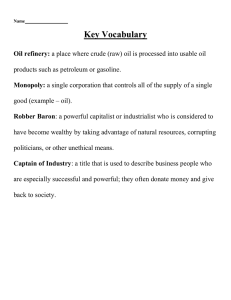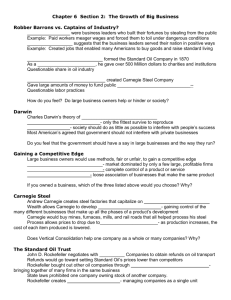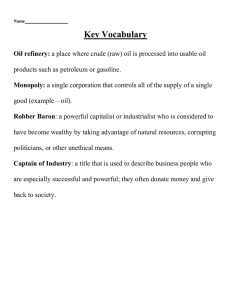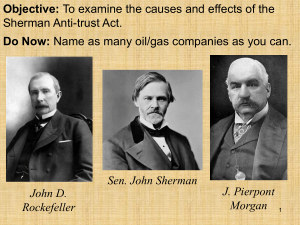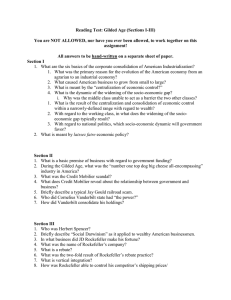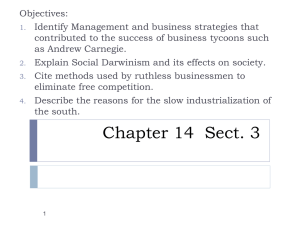The Rise of Big Business
advertisement
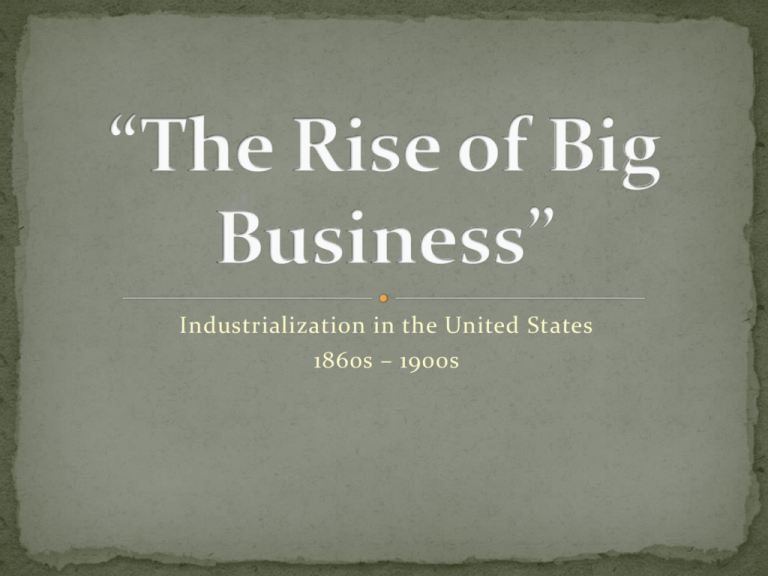
Industrialization in the United States 1860s – 1900s “Captains of Industry” Railroads Steel Oil Banking Technology Unions Cornelius Vanderbilt Andrew Carnegie John D. Rockefeller J.P. Morgan Thomas Edison Samuel Gompers Cornelius Vanderbilt Andrew Carnegie John D. Rockefeller J. P. Morgan Thomas Edison Samuel Gompers U.S. Businesses, 1870-1900 Businessmen such as Carnegie, Rockefeller, Ford and Morgan developed new methods to expand business! 140,000 120,000 100,000 80,000 U.S. Businesses, 1870-1900 New business methods, 60,000 help from the gov’t and “Captains of Industry” begin to take control of the U.S. economy... 40,000 20,000 0 1870 1880 1890 1900 Department Stores… 1862, A.T. Stewart, NYC Shopping becomes a pastime! Urban consumers. Mail-Order Catalogs… Montgomery Ward, Chicago Sears & Roebuck, 1890s Rural consumers. Rise of corporations fueled the rise of “big business…” Small businesses could not compete! Shut down in “hard times” Proprietorship Who owns it? How is money raised? Advantages Disadvantages Partnership Corporation 1 person 2 or more Investors, stockholders * Savings, loans from banks * Partners invest own money, loans from bank * Stock is sold, loans from bank * Easy! * Low fixed cost… * Small facilities! * Partners share resp… * Low fixed cost… * Limited liability for investors… * Low operating cost… * Difficult to raise money… * Limited opportunities for growth… * Owner has unlimited liability… * High operating costs… * Disagreeing partners… * Owners have unlimited liability… * High operating costs… * High fixed costs… * Large facilities and equipment… Corporation: organization owned by many people but treated by law as though it were a person. Stockholders buy stock… Raise money, spread the risk! (vs. partnership, proprietorship) Created Economies of Scale… Could produce goods more efficiently, which allowed to the rise of “big business” Produce more goods @ cheaper price, continue to operate in harsh economic times, drive out small competition! Santa Clara County v. Southern Pacific Railroad Company SCOTUS, 14th Amendment and Corporations… Received protection just as individuals would! Competition created problems; low prices for consumers!!! Railroad pools: associations of competing railroads “for the purpose of a proper division of the traffic at competitive points and the maintenance of equitable rates that may be agreed upon.” Interstate Commerce Act, 1887 By 1870s, competing businesses were merging together, creating “big business” Mergers, Consolidation of Industry 2. Creation of Trusts 3. Holding Companies 1. Example of consolidation: 1870, Rockefeller’s Standard Oil Company owned 2% of the country’s crude oil… By 1880 – it controlled 90% of U.S. crude oil! How did it do so??? Monopolies: Single company achieves control of an entire market! Trusts: Legal maneuver allowing Many states begin outlawing… trustee to control several companies & run them as one. Holding Companies: Produce no actual product. Controls several companies, merging into one large enterprise! 1. Monopolies “Carnegie Steel” Steel Refineries Railroad Lines Raw Materials Limestone Quarries Iron Ore Fields Coal Mines “Standard Oil Company” Refinery Refinery Refinery 2. Trusts … by creating Trusts! Stocks would be traded in for trust certificates. “Super-Corporation” created from many small corporations! Standard Oil, 1882 – first TRUST! J.P. Morgan Buy large blocks of stock from companies looking to sell… (discounted) Re-sell the stock for profit! These investment bankers became interested in holding companies and trusts… United States Steel, 1901


